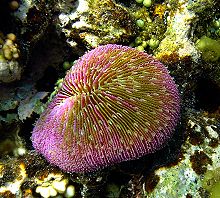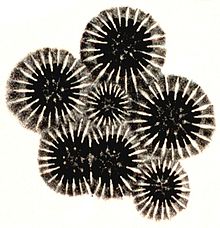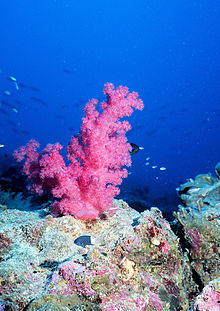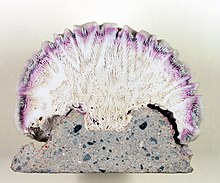From Wikipedia, the free encyclopedia
| Coral | |
|---|---|
 |
|
| Pillar coral, Dendrogyra cylindricus | |
| Scientific classification | |
| Kingdom: | Animalia |
| Phylum: | Cnidaria |
| Class: | Anthozoa Ehrenberg, 1831 |
| Extant Subclasses and Orders | |
| Alcyonaria Alcyonacea Helioporacea Zoantharia Antipatharia Corallimorpharia Scleractinia Zoanthidea [1][2] See Anthozoa for details |
|
Corals are marine invertebrates in the class Anthozoa of phylum Cnidaria. They typically live in compact colonies of many identical individual polyps. The group includes the important reef builders that inhabit tropical oceans and secrete calcium carbonate to form a hard skeleton.
A coral "head" is a colony of myriad genetically identical polyps. Each polyp is a spineless animal typically only a few millimeters in diameter and a few centimeters in length. A set of tentacles surround a central mouth opening. An exoskeleton is excreted near the base. Over many generations, the colony thus creates a large skeleton that is characteristic of the species. Individual heads grow by asexual reproduction of polyps. Corals also breed sexually by spawning: polyps of the same species release gametes simultaneously over a period of one to several nights around a full moon.
Although some corals can catch small fish and plankton, using stinging cells on their tentacles, like those in sea anemone and jellyfish, most corals obtain the majority of their energy and nutrients from photosynthetic unicellular algae that live within the coral's tissue called zooxanthella (also known as Symbiodinium). Such corals require sunlight and grow in clear, shallow water, typically at depths shallower than 60 metres (200 ft). Corals can be major contributors to the physical structure of the coral reefs that develop in tropical and subtropical waters, such as the enormous Great Barrier Reef off the coast of Queensland, Australia. Other corals do not have associated algae and can live in much deeper water, with the cold-water genus Lophelia surviving as deep as 3,000 metres (9,800 ft).[3]
Examples live on the Darwin Mounds, north-west of Cape Wrath, Scotland. Corals have also been found off the coast of the U.S. in Washington State and the Aleutian Islands in Alaska.
Taxonomy
Hermatypic corals
Hermatypic corals in the order Scleractinia are stony corals that build reefs. They mostly obtain at least part of their energy requirements from zooxanthella (Symbiodinium), symbiotic photosynthetic microalgae. They secrete calcium carbonate to form a hard skeleton. Those having six or fewer lines of symmetry in their body structure are called hexacorallia or Zoantharia. This group includes reef-building corals (scleractinians), sea anemones and zoanthids. Hermatypic genera include Scleractinia, Millepora, Tubipora and Heliopora.[5]In the Caribbean alone, at least 50 species of uniquely structured hard coral exist. Well-known types include:
- Brain corals grow to 1.8 meters (6 ft) in width.
- Acropora and staghorn corals grow fast and large, and are important reef-builders. Staghorn coral displays large, antler-like branches, and grows in areas with strong surf.
- Pillar coral forms pillars which can grow to 3 meters (10 ft) in height.
- Leptopsammia, or rock coral, appears almost everywhere in the Caribbean.[6]
Ahermatypic corals[edit]
Ahermatypic corals have no zooxanthella (Symbiodinium). They have eight tentacles and are also called octocorallia. They include corals in subclass Alcyonacesdasda, as well as some species in order Anthipatharia (black coral, Cirripathes, Antipathes).[5] Ahermatypic corals, such as sea whips, sea feathers, and sea pens,[6] are also known as soft corals. Unlike stony corals, they are flexible, undulating in the current, and often are perforated, with a lacy appearance. Their skeletons are proteinaceous, rather than calcareous. Soft corals are somewhat less plentiful (in the Caribbean, twenty species appear) than stony corals.Perforate corals
Corals can be perforate or imperforate. Perforate corals have porous skeletons, which allows their polyps to connect with each other through the skeleton. Imperforate corals have hard solid skeletons.[7][8]Anatomy
Flight through a µCT image stack of an Acropora coral from three views – note that the "arms" are mostly hollow. This coral had been hot glued into a stone and late grew over it.
The Muslim polymath Al-Biruni (d. 1048) classified sponges and corals as animals arguing that they respond to touch.[9] Nevertheless, people believed coral to be a plant until the 18th century, when William Herschel used a microscope to establish that coral had the characteristic thin cell membranes of an animal.[10]
Colonial form
The polyps interconnect by a complex and well-developed system of gastrovascular canals, allowing significant sharing of nutrients and symbiotes. In soft corals, these range in size from 50–500 micrometres (0.002–0.020 in) in diameter, and allow transport of both metabolites and cellular components.[11]Polyp
While the coral head is the familiar visual form of a single organism, it is actually a group of many individual, yet genetically identical, multicellular organisms known as polyps. Polyps are usually a few millimeters in diameter, and are formed by a layer of outer epithelium and inner jellylike tissue known as the mesoglea. They are radially symmetrical, with tentacles surrounding a central mouth, the only opening to the stomach or coelenteron, through which food is ingested and waste expelled.Exoskeleton
The stomach closes at the base of the polyp, where the epithelium produces an exoskeleton called the basal plate or calicle (L. small cup). The calicle is formed by a thickened calcareous ring (annular thickening) with six supporting radial ridges (as shown below). These structures grow vertically and project into the base of the polyp. When a polyp is physically stressed, its tentacles contract into the calyx so that virtually no part is exposed above the skeletal platform. This protects the organism from predators and the elements.[12][13]The polyp grows by extension of vertical calices which occasionally septate to form a new, higher, basal plate. Over many generations, this extension forms the large calcareous structures of corals and ultimately coral reefs.
Formation of the calcareous exoskeleton involves deposition of the mineral aragonite by the polyps from calcium and carbonate ions they acquire from seawater. The rate of deposition, while varying greatly across species and environmental conditions, can reach 10 g/m² per day (0.3 ounce/sq yd/day). This is light dependent, with night-time production 90% lower than that during the middle of the day.[14]

Nematocyst discharge: A dormant nematocyst discharges response to nearby prey touching the cnidocil, the operculum flap opens, and its stinging apparatus fires the barb into the prey, leaving a hollow filament through which poisons are injected to immobilise the prey, then the tentacles manoeuvre the prey to the mouth.
Tentacles
Nematocysts at the tips of the calices are stinging cells that carry venom which they rapidly release in response to contact with another organism. The tentacles also bear a contractile band of epithelium called the pharynx. Jellyfish and sea anemones also carry nematocysts.Nervous system
Modified epidermal cells -- neurons—contain long, thin strand-like processes, called neurites, synapsing into each other and creating a basic neural network. Corals and other cnidarians have two separate networks: one fast conducting and one slow conducting. It is believed that corals were one of the first animals to evolve such networks -- sponges have ion channels and inactive DNA for neuron production, but corals realise them fully.Ecology
Feeding
Polyps feed on a variety of small organisms, from microscopic demersal plankton to small fish. The polyp's tentacles immobilize or kill prey using their nematocysts (also known as 'cnidocysts'). The tentacles then contract to bring the prey into the stomach. Once the prey is digested, the stomach reopens, allowing the elimination of waste products and the beginning of the next hunting cycle. They can scavenge drifting organic molecules and dissolved organic molecules.[15]:24Intracellular symbionts
Many corals, as well as other cnidarian groups such as Aiptasia (a sea anemone) form a symbiotic relationship with a class of algae, zooxanthellae, of the genus Symbiodinium, a dinoflagellate.[15]:24 Aiptasia, a familiar pest among coral reef aquarium hobbyists, serves as a valuable model organism in the study of cnidarian-algal symbiosis. Typically, each polyp harbors one species of algae. Via photosynthesis, these provide energy for the coral, and aid in calcification.[16] As much as 30% of the tissue of a polyp may be plant material.[15]:23The algae benefit from a safe place to live and consume the polyp's carbon dioxide and nitrogenous waste. Due to the strain the algae can put on the polyp, stress on the coral often drives them to eject the algae. Mass ejections are known as coral bleaching, because the algae contribute to coral's brown coloration; other colors, however, are due to host coral pigments, such as green fluorescent proteins (GFPs). Ejection increases the polyp's chance of surviving short-term stress—they can regain algae, possibly of a different species at a later time. If the stressful conditions persist, the polyp eventually dies.[17]
Reproduction
Corals can be both gonochoristic (unisexual) and hermaphroditic, each of which can reproduce sexually and asexually. Reproduction also allows coral to settle in new areas.Sexual
Corals predominantly reproduce sexually. About 25% of hermatypic corals (stony corals) form single sex (gonochoristic) colonies, while the rest are hermaphroditic.[18]
Broadcasters
About 75% of all hermatypic corals "broadcast spawn" by releasing gametes—eggs and sperm—into the water to spread offspring. The gametes fuse during fertilization to form a microscopic larva called a planula, typically pink and elliptical in shape. A typical coral colony forms several thousand larvae per year to overcome the odds against formation of a new colony.[19]Synchronous spawning is very typical on the coral reef, and often, even when multiple species are present, all corals spawn on the same night. This synchrony is essential so male and female gametes can meet. Corals rely on environmental cues, varying from species to species, to determine the proper time to release gametes into the water. The cues involve temperature change, lunar cycle, day length, and possibly chemical signalling.[18] Synchronous spawning may form hybrids and is perhaps involved in coral speciation.[20] The immediate cue is most often sunset, which cues the release.[18] The spawning event can be visually dramatic, clouding the usually clear water with gametes.
Brooders
Brooding species are most often ahermatypic (not reef-building) in areas of high current or wave action. Brooders release only sperm, which is negatively buoyant, sinking on to the waiting egg carriers who harbor unfertilized eggs for weeks. Synchronous spawning events sometimes occurs even with these species.[18] After fertilization, the corals release planula that are ready to settle.[16]Planulae
Planulae exhibit positive phototaxis, swimming towards light to reach surface waters, where they drift and grow before descending to seek a hard surface to which they can attach and begin a new colony. They also exhibit positive sonotaxis, moving towards sounds that emanate from the reef and away from open water.[21] High failure rates afflict many stages of this process, and even though millions of gametes are released by each colony, few new colonies form. The time from spawning to settling is usually two to three days, but can be up to two months.[22] The larva grows into a polyp and eventually becomes a coral head by asexual budding and growth.Asexual
Within a coral head, the genetically identical polyps reproduce asexually, either via gemmation (budding) or by longitudinal or transversal division, both shown in the photo of Orbicella annularis.
Budding involves splitting a smaller polyp from an adult.[19] As the new polyp grows, it forms its body parts. The distance between the new and adult polyps grows, and with it, the coenosarc (the common body of the colony; see coral anatomy). Budding can be:
- Intratentacular—from its oral discs, producing same-sized polyps within the ring of tentacles
- Extratentacular—from its base, producing a smaller polyp
Asexual reproduction has several benefits for these sessile colonial organisms:[23]
- Cloning allows high reproduction rates, supporting rapid habitat exploitation.
- Modular growth allows biomass to increase without a corresponding decrease in surface-to-volume ratio.
- Modular growth delays senescence, by allowing the clone-type to survive the loss of one or more modules.
- New modules can replace dead modules, reducing clone-type mortality and preserving the colony's territory.
- Spreading the clone type to distant locations reduces clone-type mortality from localized threats.
Colony division
Whole colonies can reproduce asexually, forming two colonies with the same genotype.[citation needed]- Fission occurs in some corals, especially among the family Fungiidae, where the colony splits into two or more colonies during early developmental stages.
- Bailout occurs when a single polyp abandons the colony and settles on a different substrate to create a new colony.
- Fragmentation involves individuals broken from the colony during storms or other disruptions. The separated individuals can start new colonies.
Reefs
The hermatypic, stony corals are often found in coral reefs, large calcium carbonate structures generally found in shallow, tropical water. Reefs are built up from coral skeletons, and are held together by layers of calcium carbonate produced by coralline algae. Reefs are extremely diverse marine ecosystems hosting over 4,000 species of fish, massive numbers of cnidaria, mollusks, crustacea, and many other animals.[24]
Evolutionary history
|
||
|
||
|
||
|
||
| Horn coral fossil. |
Although corals first appeared in the Cambrian period,[25] some 542 million years ago, fossils are extremely rare until the Ordovician period, 100 million years later, when rugose and tabulate corals became widespread. Paleozoic corals often contained numerous endobiotic symbionts.[26][27]
Tabulate corals occur in limestones and calcareous shales of the Ordovician and Silurian periods, and often form low cushions or branching masses alongside rugose corals. Their numbers began to decline during the middle of the Silurian period, and they became extinct at the end of the Permian period, 250 million years ago. The skeletons of tabulate corals are composed of a form of calcium carbonate known as calcite.
Rugose corals became dominant by the middle of the Silurian period, and became extinct early in the Triassic period. The rugose corals existed in solitary and colonial forms, and were also composed of calcite.
The scleractinian corals filled the niche vacated by the extinct rugose and tabulate species. Their fossils may be found in small numbers in rocks from the Triassic period, and became common in the Jurassic and later periods. Scleractinian skeletons are composed of a form of calcium carbonate known as aragonite.[28] Although they are geologically younger than the tabulate and rugose corals, their aragonitic skeleton is less readily preserved, and their fossil record is less complete.
 |
|
| Timeline of the major coral fossil record and developments from 650 m.y.a. to present.[29][30] | |
Fossils of fellow reef-dwellers algae, sponges, and the remains of many echinoids, brachiopods, bivalves, gastropods, and trilobites appear along with coral fossils. This makes some corals useful index fossils that enabled geologists to date the rocks in which they are found. Coral fossils are not restricted to reef remnants, and many solitary fossils may be found elsewhere, such as Cyclocyathus, which occurs in England's Gault clay formation.
A Petoskey stone is a rock and a fossil, often pebble-shaped, that is composed of a fossilized coral, Hexagonaria percarinata. They are found predominantly in Michigan's Upper Peninsula, and the northwestern portion of Michigan's Lower Peninsula.
Status
Threats
Coral reefs are under stress around the world.[31] In particular, coral mining, agricultural and urban runoff, pollution (organic and inorganic), overfishing, blast fishing, disease, and the digging of canals and access into islands and bays are localized threats to coral ecosystems. Broader threats are sea temperature rise, sea level rise and pH changes from ocean acidification, all associated with greenhouse gas emissions.[32] In 1998, 16% of the world's reefs died as a result of increased water temperature.[33]
General estimates show approximately 10% of the world's coral reefs are dead.[34][35][36] About 60% of the world's reefs are at risk due to human-related activities.[37] The threat to reef health is particularly strong in Southeast Asia, where 80% of reefs are endangered.[citation needed] Over 50% of the world's coral reefs may be destroyed by 2030; as a result, most nations protect them through environmental laws.[38]
In the Caribbean and tropical Pacific, direct contact between ~40–70% of common seaweeds and coral causes bleaching and death to the coral via transfer of lipid-soluble metabolites.[39] Seaweed and algae proliferate given adequate nutrients and limited grazing by herbivores such as parrotfish.
Water temperature changes of more than 1–2 °C (1.8–3.6 °F) or salinity changes can kill some species of coral. Under such environmental stresses, corals expel their Symbiodinium; without them coral tissues reveal the white of their skeletons, an event known as coral bleaching.[40]
Submarine springs found along the coast of Mexico's Yucatán Peninsula produce water with a naturally low pH (a measure of acidity) providing conditions similar to those expected to become widespread as the oceans absorb carbon dioxide.[citation needed] Surveys discovered multiple species of live coral that appeared to tolerate the acidity. The colonies were small and patchily distributed, and had not formed structurally complex reefs such as those that compose the nearby Mesoamerican Barrier Reef System.[41]
Protection

Marine Protected Areas (MPAs), Biosphere reserves, marine parks, national monuments world heritage status, fishery management and habitat protection can protect reefs from anthropogenic damage.[42]
Many governments now prohibit removal of coral from reefs, and inform coastal residents about reef protection and ecology. While local action such as habitat restoration and herbivore protection can reduce local damage, the longer-term threats of acidification, temperature change and sea-level rise remain a challenge.[32]
To eliminate destruction of corals in their indigenous regions, projects have been started to grow corals in non-tropical countries.[43][44]
Relation to humans
Local economies near major coral reefs benefit from an abundance of fish and other marine creatures as a food source. Reefs also provide recreational scuba diving and snorkeling tourism. These activities can damage coral but international projects such as Green Fins that encourage dive and snorkel centres to follow a Code of Conduct has been proven to mitigate these risks.[45]Live coral is highly sought after for aquaria. Soft corals are easier to maintain in captivity than hard corals.[46]
Jewelry

6-Strand Necklace, Navajo (Native American), ca. 1920s, Brooklyn Museum
Corals' many colors give it appeal for necklaces and other jewelry. Intensely red coral is prized as a gemstone. Sometimes called fire coral, it is not the same as fire coral. Red coral is very rare because of overharvesting.[47]
Medicine
In medicine, chemical compounds from corals are used for cancer, AIDS, pain, and other uses. Coral skeletons, e.g. Isididae are also used for bone grafting in humans.[48] Coral Calx, known as Praval Bhasma in Sanskrit, is widely used in traditional system of Indian medicine as a supplement in the treatment of a variety of bone metabolic disorders associated with calcium deficiency.[49]Construction
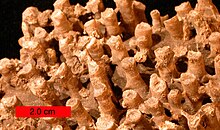
Tabulate coral (a syringoporid); Boone limestone (Lower Carboniferous) near Hiwasse, Arkansas, scale bar is 2.0 cm
Coral reefs on land provide lime for use as building blocks ("coral rag"). Coral rag is an important local building material in places such as the East African coast.[citation needed]
Climate research
The annual growth bands in deep sea bamboo corals (Isididae) and others may be among the ocean's first organisms to display the effects of ocean acidification. They produce growth rings similar to those of trees, and can provide a view of changes in the condition in the deep sea over time.[50] They allow geologists to construct year-by-year chronologies, a form of incremental dating, which underlie high-resolution records of past climatic and environmental changes using geochemical techniques.[51]Certain species form communities called microatolls, which are colonies whose top is dead and mostly above the water line, but whose perimeter is mostly submerged and alive. Average tide level limits their height. By analyzing the various growth morphologies, microatolls offer a low resolution record of sea level change. Fossilized microatolls can also be dated using radioactive carbon dating. Such methods can help to reconstruct Holocene sea levels.[52]
Increasing sea temperatures in tropical regions (~1 degree C) the last century have caused major coral bleaching, death, and therefore shrinking coral populations since although they are able to adapt and acclimate, it is uncertain if this evolutionary process will happen quickly enough to prevent major reduction of their numbers.[53]
Though coral have big populations and phenomenal sexual capabilities as well as zooxanthellae being diverse, evolution is sometimes slowed by abundant asexual reproduction.[54] It seems as though the gene pool is certainly diverse, but the slow adaptation could be due to a lack of alleles mixing through sexual reproduction. Also, gene flow is variable among coral species.[54] According to the biogeography of coral species gene flow cannot be counted on as a dependable source of adaptation as they are very stationary organisms. Also, coral longevity might factor into their adaptivity.[54] Their long life span yields fewer generations per year and therefore mutation rates are lower than shorter generation organisms. This does not allow for much selection, adaptation, and successful evolution of a species.
However, evidence of coral adaptation to climate changes has been shown in many cases. These are usually due to a shift in coral and zooxanthellae genotypes as is typical of evolution when selection factors change. These shifts in allelic frequencies have already been progressing toward more tolerant types of zooxanthellae.[55] Scientists found that a certain scleractinian colonies of zooxanthellae are becoming more common in areas of high sea temperatures.[56] It may cause a bottleneck in the endosymbiont gene pool, however this genotype may rescue the coral populations from complete decimation in the coming years. Though there may be this adaption to more tolerant zooxanthellae, there will be costs in communal layout and output.[57] Meaning the lowered variety in alleles and change in selection pressures may cause other physiological cost to the organisms. These more favorable symbionts seem to have slower photosynthesis rates.[57] This trade off indicates an evolutionary shift of what traits are most selected for in the current environment in terms of survival.
Another coral evolutionary response are refugia population shifts as a reaction to temperature pressures. In the Gulf of Mexico, where sea temperatures are indeed rising, there has been a migration of cold-sensitive staghorn and elkhorn coral.[55] Not only have the symbionts and specific species been shown to shift, there seems to be a certain growth rate favorable to selection. It has been found that slower growing coral have become more common as they are more heat tolerant.[58] However, the changes in temperature and acclimation are complex. Some reefs in current shadows represent a refugium location that will help them adjust to the disparity in the environment even if eventually the temperatures may be rising more quickly there than other locations.[59] This vicariance due to climatic barriers causes a realized niche to shrink greatly in comparison to the old fundamental niche. Scientists have found direct evidence of selection acting upon this coral life system by exploring different angles of adaptation, but conclusions are difficult to draw.
Aquaria

The saltwater fishkeeping hobby has increasingly expanded, over recent years, to include reef tanks, fish tanks that include large amounts of live rock on which coral is allowed to grow and spread.[60] These tanks are either kept in a natural-like state, with algae (sometimes in the form of an algae scrubber) and a deep sand bed providing filtration,[61] or as "show tanks", with the rock kept largely bare of the algae and microfauna that would normally populate it,[62] in order to appear neat and clean.
The most popular kind of coral kept is soft coral, especially zoanthids and mushroom corals, which are especially easy to grow and propagate in a wide variety of conditions,[63] because they originate in enclosed parts of reefs where water conditions vary and lighting may be less reliable and direct.[64] More serious fishkeepers may keep small polyp stony coral, which is from open, brightly lit reef conditions and therefore much more demanding, while large polyp stony coral is a sort of compromise between the two.
